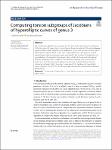Search
Author
- Carlos, Alegría (2)
- Carlos, Seara (2)
- David, Orden (2)
- Klaus, Bretterbauer (2)
- next >
Subject
Date issued
Has File(s)
- true (287)
Search Results
For the Neumann-Poincaré (double layer potential) operator in the three-dimensional elasticity we establish asymptotic formulas for eigenvalues converging to the points of the essential spectrum and discuss geometric and mechanical meaning of coefficients in these formulas. In particular, we establish that for any body, there are infinitely many eigenvalues converging from above to each point of the essential spectrum. On the other hand, if there is a point where the boundary is concave (in particular, if the body contains cavities) then for each point of the essential spectrum there exists a sequence of eigenvalues converging to this point from below. |
We study a model for adversarial classification based on distributionally robust chance constraints. We show that under Wasserstein ambiguity, the model aims to minimize the conditional value-at-risk of the distance to misclassification, and we explore links to adversarial classification models proposed earlier and to maximum-margin classifiers. We also provide a reformulation of the distributionally robust model for linear classification, and show it is equivalent to minimizing a regularized ramp loss objective. |
Smooth algebraic plane quartics over algebraically closed fields of characteristic different than two have 28 bitangent lines. Their tropical counterparts often have infinitely many bitangents. They are grouped into seven equivalence classes, one for each linear system associated to an effective tropical theta characteristic on the tropical quartic. We show such classes determine tropically convex sets and provide a complete combinatorial classification of such objects into 41 types (up to symmetry). |
The main aim of the paper is to extend criticality theory to the operator Q′p,A,V. In particular, we prove an Agmon-Allegretto-Piepenbrink (AAP) type theorem, establish the uniqueness and simplicity of the principal eigenvalue of Q′p,A,V in a domain ω⋐Ω, and give various characterizations of criticality. Furthermore, we also study positive solutions of the equation Q′p,A,V[u]=0 of minimal growth at infinity in Ω, the existence of a minimal positive Green function, and the minimal decay at infinity of Hardy-weights. |
This article is a natural continuation of the paper Tiwari, D., Giordano, P., Hyperseries in the non-Archimedean ring of Colombeau generalized numbers in this journal. We study one variable hyper-power series by analyzing the notion of radius of convergence and proving classical results such as algebraic operations, composition and reciprocal of hyper-power series. We then define and study one variable generalized real analytic functions, considering their derivation, integration, a suitable formulation of the identity theorem and the characterization by local uniform upper bounds of derivatives. |
Tumour spheroids have been the focus of a variety of mathematical models, ranging from Greenspan’s classical study of the 1970 s through to contemporary agent-based models. Of the many factors that regulate spheroid growth, mechanical effects are perhaps some of the least studied, both theoretically and experimentally, though experimental enquiry has established their significance to tumour growth dynamics. In this tutorial, we formulate a hierarchy of mathematical models of increasing complexity to explore the role of mechanics in spheroid growth, all the while seeking to retain desirable simplicity and analytical tractability. |
We propose and analyze a family of epidemiological models that extend the classic Susceptible-Infectious-Recovered/Removed (SIR)-like framework to account for dynamic heterogeneity in infection risk. The family of models takes the form of a system of reaction–diffusion equations given populations structured by heterogeneous susceptibility to infection. These models describe the evolution of population-level macroscopic quantities S, I, R as in the classical case coupled with a microscopic variable f, giving the distribution of individual behavior in terms of exposure to contagion in the population of susceptibles. |
We introduce an algorithm to compute the structure of the rational torsion subgroup of the Jacobian of a hyperelliptic curve of genus 3 over the rationals. We apply a Magma implementation of our algorithm to a database of curves with low discriminant due to Sutherland as well as a list of curves with small coefficients. In the process, we find several torsion structures not previously described in the literature. The algorithm is a generalisation of an algorithm for genus 2 due to Stoll, which we extend to abelian varieties satisfying certain conditions. |
The maximum likelihood decoding problem (MLD) is known to be NP-hard and its complexity is strictly related to the security of some post-quantum cryptosystems, that is, the so-called code-based primitives. Analogously, the multivariate quadratic system problem (MQ) is NP-hard and its complexity is necessary for the security of the so-called multivariate-based primitives. In this paper we present a closed formula for a polynomial-time reduction from any instance of MLD to an instance of MQ, and viceversa. We also show a polynomial-time isomorphism between MQ and MLD, thus demonstrating the direct link between the two post-quantum cryptographic families. |
It is well known that if a finite set A⊂Z tiles the integers by translations, then the translation set must be periodic, so that the tiling is equivalent to a factorization A⊕B=ZM of a finite cyclic group. We are interested in characterizing all finite sets A⊂Z that have this property. Coven and Meyerowitz (J Algebra 212:161–174, 1999) proposed conditions (T1), (T2) that are sufficient for A to tile, and necessary when the cardinality of A has at most two distinct prime factors. They also proved that (T1) holds for all finite tiles, regardless of size. |










